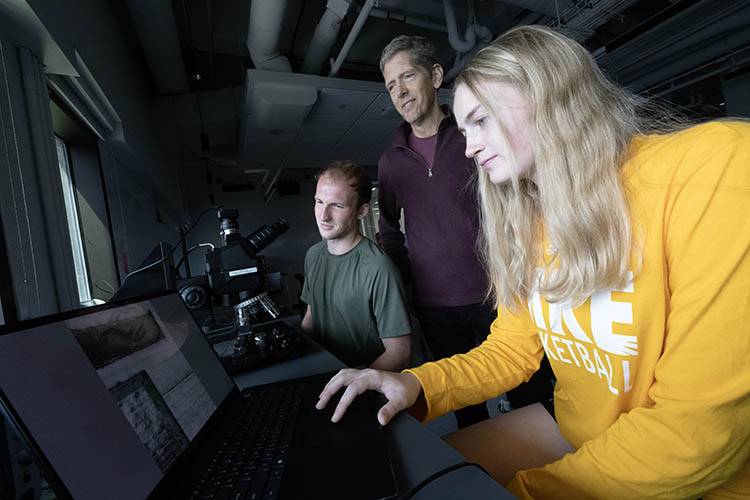Metamaterials that can change shape, a study to determine how zero gravity conditions of space affect breast cancer, and a chemical-imaging instrument that can see the inside of pharmaceutical tablets are the three new research projects being funded by the UWM Graduate School’s Discovery and Innovation Grant (DIG) program. This yearlong, internal seed funding prioritizes new lines of research that have high external funding potential. Twelve grants were awarded for the 2024 cycle. Hats off to the five researchers from the College of Engineering & Applied Science!
Shape-shifting metamaterial
- Daniel Schlitz, research scientist, civil engineering
- Rani El Hajjar, professor, civil engineering
- Chiu-Tai Law, professor, electrical engineering
The goal of this project is to invent a metamaterial that can change shape, articulate and grasp – like an octopus’ arm.
Metamaterials are engineered with repeating patterns of nano- and micro-scale structures that create unique properties or motion that cannot be found in conventional materials.
The research starts with a polymer that produces a small movement when subjected to an electric field. This material is then engineered into a metamaterial that amplifies the displacement of the polymer members. This means it is capable of locally expanding or contracting to create lifelike movement.
Many of the potential applications are in the field of robotics. The flexibility and potential for integrated sensors can make this an ideal material for soft robotics, where humans wear robotic devices, or the material serves as an artificial muscle for robot mobility.
The effect of microgravity on breast cancer
- Qingsu Cheng, assistant professor, biomedical engineering
Changing gravity influences biological processes. In space, for example, astronauts can lose muscle mass faster than they would on Earth without proper diet and exercise.
But currently, the effect of reduced or zero gravity on breast cancer development – inhibition or progression – is not fully understood.
Cheng’s research focuses on the search for new treatments for breast cancer. In his project, he will use primary cells and patient-derived organoids to examine mammographic density in microgravity. Patient-derived organoids are 3D cell cultures that are grown in the lab from tissue samples taken from patients.
Breast tissue density is considered one of the main risk factors for the disease, behind BRCA gene mutation and aging. Results of the project could offer new knowledge of the impact of gravity on biological life and processes.
Hyperspectral spatial-frequency domain imaging of pharmaceutical tablets
- Yongjin Sung, associate professor, mechanical engineering
Sung will develop a nondestructive chemical-imaging instrument that can see the inside of pharmaceutical tablets so that scientists can identify the distribution of their active pharmaceutical ingredients.
In drugs that are time-released or involve different delivery profiles, the active ingredients need to be properly distributed within to be effective. At issue are 3D printed tablets, in which a single tablet can contain more than one phase of active ingredients. This allows a patient who needs to take multiple medications to reduce their dose to a single tablet.
The ingredients are mixed in such a way that the various active components, which act in different ways, remain separate from one another.
Existing imaging methods do not work because the tablets are strongly absorbing and highly scattering. Sung will overcome these obstacles with cutting-edge hardware and software.
